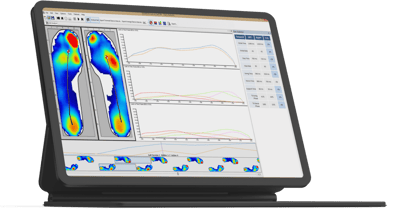
Improve Sports Performance: Gait Optimization
Be faster, play better and run effectively by optimising gait.
Sports performance and human performance go hand in hand. After all, the way a human moves — from the way they walk and run to the way they jump and skip — determines everything from speed and power to efficiency to effectiveness. And, as an athlete, all of these things start to matter on a higher level.
It’s why we place such an emphasis on gathering precise plantar pressure and gait data at XSENSOR. By recording, measuring and then optimising gait, we’re able to help trainers, medical professionals and athletes level up their sports performance, improve their speed, power and even level up their comfort.
Where gait comes into play
When you start to gather data around sports performance and athletic effectiveness, it’s easy to see how important the so-called ‘little’ things are. After all, just a quarter of a second separates the world’s top 5 fastest 100 metre sprinters — and the athletes that compete in races and events, like the Olympics, know this. There’s never a massive difference between elite professional athletes… there are only ever milliseconds.
And optimising gait is how you optimise those milliseconds.
Through biomechanics research, you can optimise human and sports performance with high-powered, highly-detailed visualisations and data that speaks to the individual athlete and their individual gait. This can help with everything from evaluating orthotic or footwear effectiveness to reducing injury risk to improving speed, almost instantly improving that athletic sports performance (or identifying where it needs to be improved).

Understanding gait
When understanding gait as it pertains to sports performance, getting down to the basics is key — and gait itself is made up of two main phases, the stance phase and the swing phase.
The stance phase itself is made up of four separate mini-phases: loading response, midstance, terminal stance and pre-swing. In the loading response phase, the foot makes initial contact with the ground, before the alternate leg ever swings. In the midstance phase, the body moves its center of gravity over the moving foot, preparing the body for swing in the terminal stance as that heel leaves the ground and begins pre-swing.
Then, you have the swing phase of gait — which is all about the swinging of the leg to move the body forward, starting with the initial swing and a phase called “toe off.” The leg reaches maximum knee flexion as it swings forward, swinging the body into midswing as the weight supporting leg helps propel the body forward until the tibia is perpendicular to the ground. Terminal swing, which ends as the foot makes contact with the ground, makes room for the gait cycle to continue cycling onward.
The key? Finding the perfect balance — and understanding that gait — through gait analysis that works with your sports performance, not against it.
Sports Performance Gait Optimization with XSENSOR
At XSENSOR, we offer several tools and solutions to help with sports performance and gait optimization. They’re all rooted in Intelligent Dynamic Sensing, our innovative offering built to reveal hidden data in ways that don’t interfere with day-to-day life, and they’re designed to provide insights to everyone from athletic trainers to athletes to medical professionals.
First up, our Gait & Motion insoles help capture lab-quality data in the field. These intelligent insoles are designed specifically to help capture real-world data (i.e., true sprinting or actual jogging) in a way that’s been incredibly limited in the past — giving everyone the opportunity to reference natural gait.
The Gait & Motion insoles are more than just a simple insole, too — they’re accurate and repeatable with a +/- 5% full-scale error, fast sensor response, high-resolution data and high-speed collection up to 150 Hz. The advanced, AI-powered gait analysis tools themselves are also reliable and repeatable in a large number of areas and situations.
Next, our Walkway and Stance Pad sensors come into help accurately and adequately capture plantar pressure data and, in turn, gait. These sensors are high-resolution in a way that other sensors on the market simply are not, and their low-profile, portable design makes them a no-brainer for anyone needing to assess gait, no matter where they are in the field.
The Stance Pad sensors are 5 mm resolution to capture quality plantar surface pressure data, and the 1 cm walkway resolution accurately captures the pressure distribution needed with the data itself. The AI-powered sensors provide incredible insights and are reliable within 5% — as well as repeatable, time and time again.
At XSENSOR, data collection to help with optimization is what we do. Our solutions use intelligent dynamic sensing alongside high-quality data collection to help you, your patients and everyone in between creating a well-optimised life. And, whether you and your facility are looking to lower injury rates, increase speed or do something totally different, we’re here to help.

